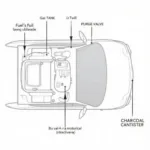Clearing OBD2 codes is a common practice for many car owners, often done to see if a problem is truly fixed or just a temporary glitch. But is it the right approach? This article will delve into the intricacies of clearing OBD2 codes to determine if a component is genuinely faulty, providing you with the knowledge to diagnose car problems effectively.
Many car owners wonder if clearing OBD2 codes is a viable way to identify faulty components. The answer is both yes and no. While clearing codes can temporarily extinguish the check engine light, it doesn’t fix the underlying issue. Think of it like silencing a fire alarm without addressing the fire itself. obd2 code p0133 vw
Understanding OBD2 Codes and Their Purpose
OBD2 codes are essentially trouble codes stored in your vehicle’s computer. They pinpoint potential problems within various systems, from the engine and transmission to the emissions system. These codes are invaluable for mechanics and DIYers alike, offering clues to diagnose and repair automotive issues.
Why Clearing Codes Isn’t Always the Best First Step
Clearing codes prematurely can mask intermittent problems, making diagnosis much more challenging. Imagine a loose connection causing a sporadic sensor reading. Clearing the code without investigating further might lead you to believe the problem is resolved when it’s likely to reappear. reset airbag light obd2 k1500
 OBD2 Scanner Diagnosing Car Problem
OBD2 Scanner Diagnosing Car Problem
How to Properly Use Code Clearing for Diagnosis
Clearing codes strategically, however, can be a useful diagnostic tool. After making a repair or addressing a suspected problem, clearing the codes allows you to see if the issue has truly been resolved. If the code returns, you know the problem persists, and further investigation is required. ratings reviews of ancel ad310 obd2 code reader
Steps for Effective Diagnosis Using Code Clearing:
- Read the Codes: Use an OBD2 scanner to retrieve the stored codes.
- Research the Codes: Understand what each code signifies. Online resources and repair manuals can provide valuable information.
- Address the Suspected Problem: Make the necessary repairs or replacements.
- Clear the Codes: After the repair, clear the codes using your scanner.
- Monitor for Code Reappearance: Drive the vehicle under normal conditions. If the code returns, the problem is not fixed.
“Clearing codes is like resetting a trip odometer. It doesn’t change the distance traveled, but it starts a new count,” says Alex Thompson, a seasoned automotive technician. “It’s a tool, not a solution.”
When Not to Clear OBD2 Codes
Avoid clearing codes before taking your vehicle to a mechanic. The stored codes are crucial for them to diagnose the issue quickly and accurately. Clearing them can prolong the diagnostic process and potentially lead to unnecessary repairs. arduino obd2 emmisions fix
“Bringing a car in with cleared codes is like going to the doctor after taking a pain reliever,” adds Thompson. “It masks the symptoms, making diagnosis more difficult.” diagnosis obd2 maxiscan ms509
Conclusion: Clearing OBD2 Codes to See If Faulty – A Cautious Approach
Clearing OBD2 codes can be a helpful part of the diagnostic process when used correctly. However, it’s essential to understand its limitations. Clearing codes doesn’t fix the underlying problem; it simply resets the system. By understanding the information presented here, you can effectively use code clearing as a tool for diagnosis, helping you get to the root of your vehicle’s problems.
Need Help with your car diagnostics? Contact us via WhatsApp: +1(641)206-8880, Email: [email protected] or visit us at 789 Elm Street, San Francisco, CA 94102, USA. We have a 24/7 customer support team.
